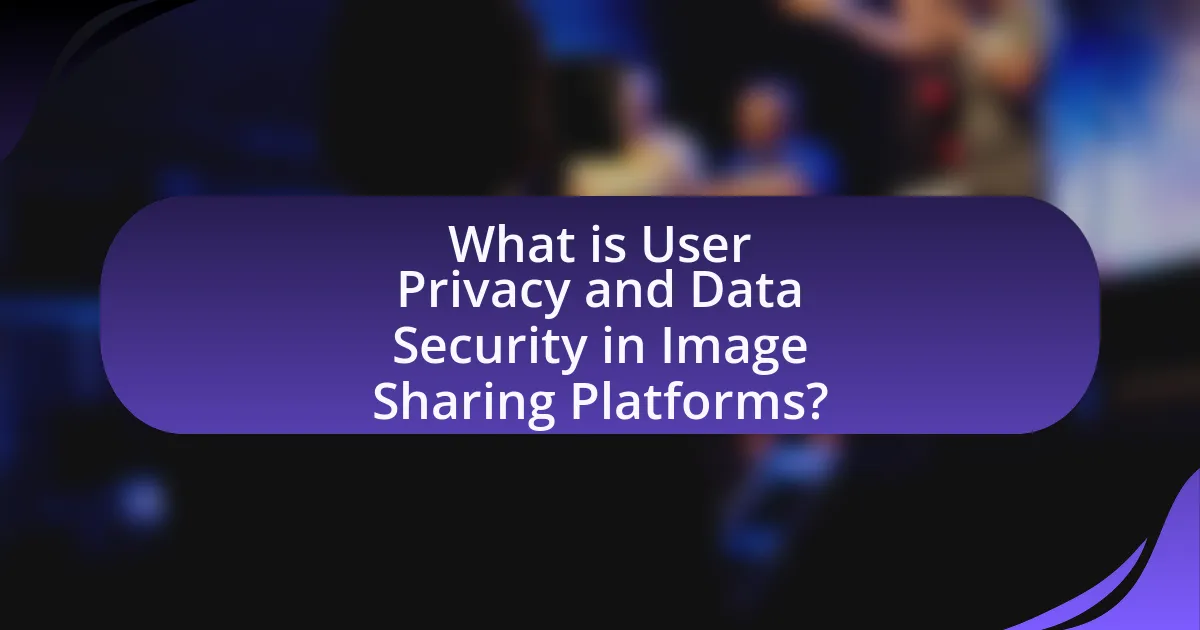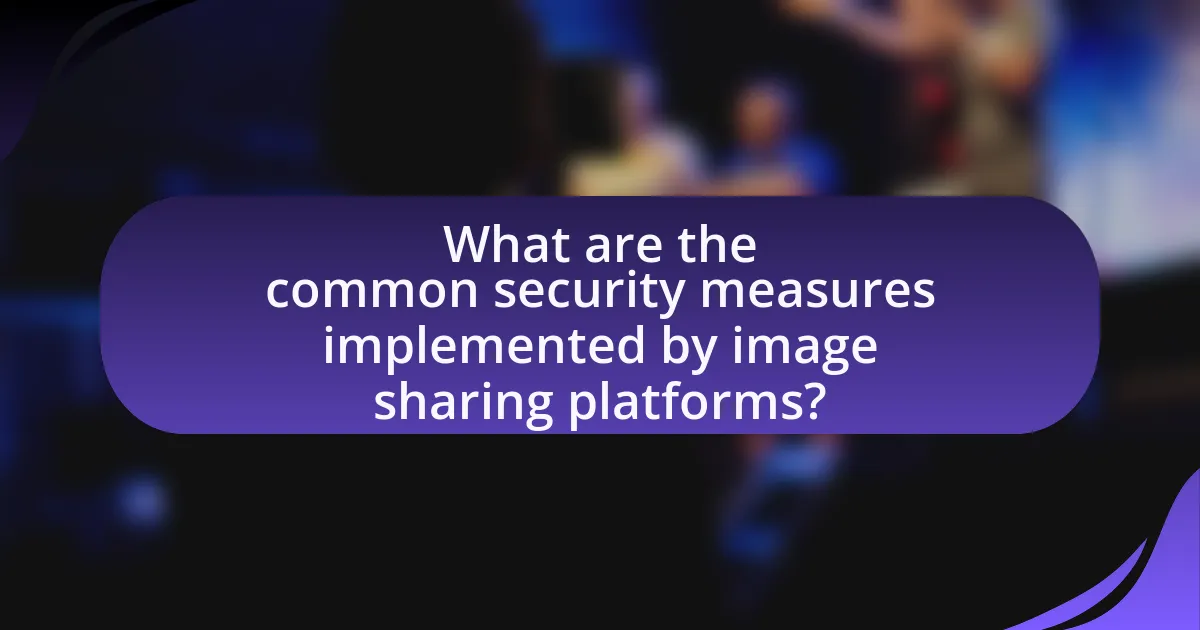User privacy and data security in image sharing platforms encompass the practices and measures that protect users’ personal information and images from unauthorized access and misuse. The article examines how these platforms handle user data, the types of data collected, and the storage and management practices in place. It highlights the importance of user privacy, potential risks associated with data breaches, and the impact of regulations like GDPR and CCPA on data protection. Additionally, it discusses common security measures, challenges in maintaining data security, and best practices users can adopt to safeguard their information while using these platforms.
What is User Privacy and Data Security in Image Sharing Platforms?

User privacy and data security in image sharing platforms refer to the measures and practices that protect users’ personal information and images from unauthorized access, misuse, or breaches. These platforms often collect sensitive data, including location, device information, and user-generated content, necessitating robust security protocols such as encryption, access controls, and compliance with regulations like GDPR. For instance, a 2021 report by the Electronic Frontier Foundation highlighted that many image sharing services lack adequate privacy settings, exposing users to potential data leaks. Therefore, effective user privacy and data security are critical for maintaining user trust and safeguarding personal information on these platforms.
How do image sharing platforms handle user data?
Image sharing platforms handle user data by implementing various privacy policies and data protection measures. These platforms typically collect user information such as email addresses, profile details, and uploaded images, which are stored in secure databases. To protect this data, they often employ encryption techniques, access controls, and regular security audits. For instance, platforms like Instagram and Flickr have privacy settings that allow users to control who can view their content and personal information. Additionally, many platforms comply with regulations such as the General Data Protection Regulation (GDPR), which mandates transparency in data usage and the right for users to request data deletion. This adherence to legal standards reinforces their commitment to user privacy and data security.
What types of user data are collected by these platforms?
Image sharing platforms collect various types of user data, including personal information, usage data, and content data. Personal information typically encompasses names, email addresses, and profile pictures, which users provide during account creation. Usage data includes information on user interactions, such as upload frequency, engagement metrics, and device information, which helps platforms analyze user behavior. Content data refers to the images and videos uploaded by users, along with associated metadata like timestamps and geolocation data, which can be extracted from the files. This comprehensive data collection enables platforms to enhance user experience, target advertisements, and improve security measures.
How is user data stored and managed on these platforms?
User data on image sharing platforms is typically stored in centralized databases managed by the service providers. These platforms utilize encryption methods to protect data during transmission and at rest, ensuring that user information remains secure from unauthorized access. For instance, many platforms implement access controls and authentication measures to restrict data access to authorized personnel only. Additionally, data management practices often include regular audits and compliance with data protection regulations, such as the General Data Protection Regulation (GDPR), which mandates strict guidelines for user data handling and storage.
Why is user privacy important in image sharing?
User privacy is crucial in image sharing because it protects individuals from unauthorized access and misuse of their personal images. When users share images, they often reveal sensitive information that can be exploited for identity theft, harassment, or other malicious activities. According to a study by the Pew Research Center, 64% of Americans have experienced a major data breach, highlighting the risks associated with sharing personal content online. Ensuring user privacy fosters trust in image sharing platforms, encouraging users to engage without fear of their data being compromised.
What are the potential risks of data breaches in image sharing?
Data breaches in image sharing pose significant risks, including unauthorized access to personal information, identity theft, and reputational damage. When images containing sensitive data are exposed, individuals may face privacy violations, leading to potential harassment or stalking. According to a 2020 report by the Identity Theft Resource Center, data breaches resulted in over 300 million records being compromised, highlighting the scale of the issue. Furthermore, leaked images can be manipulated or misused, contributing to the spread of misinformation or non-consensual sharing, which can have lasting emotional and psychological effects on victims.
How can privacy violations affect users personally and professionally?
Privacy violations can significantly impact users both personally and professionally by leading to identity theft, emotional distress, and reputational damage. When personal data is compromised, individuals may experience anxiety, loss of trust, and a sense of vulnerability, which can affect their mental health and personal relationships. Professionally, such violations can result in job loss, diminished career prospects, and damage to professional relationships, as employers may view privacy breaches as a lack of responsibility or competence. According to a 2020 study by the Identity Theft Resource Center, 47% of individuals affected by identity theft reported emotional distress, highlighting the personal toll of privacy violations. Additionally, a survey by the Ponemon Institute found that 60% of companies experienced reputational damage following a data breach, illustrating the professional consequences of compromised privacy.
What regulations govern user privacy in image sharing platforms?
Regulations that govern user privacy in image sharing platforms include the General Data Protection Regulation (GDPR) in the European Union and the California Consumer Privacy Act (CCPA) in the United States. The GDPR mandates that platforms obtain explicit consent from users before processing their personal data and provides users with rights to access, rectify, and delete their data. The CCPA grants California residents similar rights, including the ability to know what personal information is collected and the right to opt-out of its sale. These regulations aim to enhance user privacy and data protection, ensuring that image sharing platforms handle user data responsibly and transparently.
How do GDPR and CCPA impact image sharing services?
GDPR and CCPA impose strict regulations on image sharing services regarding user data protection and privacy. Under GDPR, image sharing services must obtain explicit consent from users before processing their personal data, including images that may contain identifiable information. This regulation mandates transparency about data usage and grants users rights such as data access, rectification, and deletion.
Similarly, CCPA requires image sharing services to inform users about the collection and sale of their personal data, allowing users to opt-out of such practices. Both regulations enforce significant penalties for non-compliance, which can lead to substantial financial repercussions for image sharing platforms. For instance, GDPR fines can reach up to 4% of a company’s global annual revenue, while CCPA violations can result in fines of up to $7,500 per violation. These legal frameworks compel image sharing services to implement robust data protection measures and prioritize user privacy.
What are the compliance requirements for these platforms?
The compliance requirements for image sharing platforms primarily include adherence to data protection regulations such as the General Data Protection Regulation (GDPR) in Europe and the California Consumer Privacy Act (CCPA) in the United States. These regulations mandate that platforms obtain explicit user consent for data collection, provide transparency regarding data usage, and implement robust security measures to protect user data. For instance, GDPR requires platforms to allow users to access, rectify, and delete their personal data, while CCPA grants users the right to know what personal data is being collected and the ability to opt-out of its sale. Compliance with these regulations is essential to avoid significant fines and legal repercussions, as evidenced by the enforcement actions taken against non-compliant companies, which can result in penalties reaching millions of dollars.
How can users protect their privacy on image sharing platforms?
Users can protect their privacy on image sharing platforms by adjusting their privacy settings, limiting the audience for their shared images, and being cautious about the information they include in their posts. Adjusting privacy settings allows users to control who can view their images, ensuring that only trusted individuals have access. Limiting the audience can be achieved by sharing images only with specific friends or groups rather than publicly. Additionally, users should avoid sharing personal information, such as location data or identifiable details, within their images or captions. These practices help mitigate the risk of unauthorized access and potential misuse of personal data.
What privacy settings should users be aware of?
Users should be aware of privacy settings that control who can view, comment on, and share their images. Key settings include account visibility options, which allow users to choose between public, private, or friends-only access; content sharing permissions, which dictate whether others can share their images; and location tagging settings, which enable or disable the inclusion of geographical data in posts. Additionally, users should review data retention policies and options for deleting or deactivating accounts, as these directly impact how long their information is stored and how it can be used. Understanding these settings is crucial for maintaining control over personal data and ensuring a secure experience on image sharing platforms.
How can users recognize and avoid privacy risks?
Users can recognize and avoid privacy risks by being vigilant about the permissions they grant to applications and by regularly reviewing their privacy settings. For instance, users should only allow access to personal data that is necessary for the app’s functionality, as excessive permissions can lead to unauthorized data collection. Additionally, users should familiarize themselves with the privacy policies of image-sharing platforms, which often outline how data is collected, used, and shared. According to a 2021 survey by the Pew Research Center, 81% of Americans feel they have little to no control over the data collected about them, highlighting the importance of proactive measures in managing privacy. By staying informed and cautious, users can significantly reduce their exposure to privacy risks.
What are the common security measures implemented by image sharing platforms?

Common security measures implemented by image sharing platforms include encryption, user authentication, and content moderation. Encryption protects user data during transmission and storage, ensuring that unauthorized parties cannot access sensitive information. User authentication, often through multi-factor authentication, verifies the identity of users, reducing the risk of unauthorized access to accounts. Content moderation employs automated systems and human oversight to detect and remove inappropriate or harmful content, thereby maintaining a safe environment for users. These measures collectively enhance user privacy and data security on these platforms.
How do encryption and secure connections enhance data security?
Encryption and secure connections enhance data security by protecting sensitive information from unauthorized access during transmission. Encryption transforms data into a coded format that can only be read by authorized parties with the correct decryption key, ensuring that even if data is intercepted, it remains unreadable. Secure connections, such as those established through HTTPS, utilize protocols like SSL/TLS to create a secure channel between the user and the server, preventing eavesdropping and man-in-the-middle attacks. According to a study by the Internet Engineering Task Force, the implementation of HTTPS significantly reduces the risk of data breaches, as it encrypts the data exchanged between users and platforms, thereby safeguarding user privacy and maintaining the integrity of the information shared on image sharing platforms.
What types of encryption are commonly used in image sharing?
Commonly used types of encryption in image sharing include symmetric encryption, asymmetric encryption, and hashing. Symmetric encryption, such as AES (Advanced Encryption Standard), uses the same key for both encryption and decryption, ensuring that only authorized users can access the images. Asymmetric encryption, like RSA (Rivest-Shamir-Adleman), employs a pair of keys—public and private—allowing secure sharing without needing to exchange secret keys. Hashing algorithms, such as SHA-256, are used to verify the integrity of images by generating a unique hash value that changes if the image is altered. These encryption methods enhance user privacy and data security by protecting images from unauthorized access and ensuring data integrity during transmission.
How do secure connections prevent unauthorized access?
Secure connections prevent unauthorized access by encrypting data transmitted between users and servers, ensuring that only authorized parties can read the information. This encryption process, often implemented through protocols like HTTPS, uses algorithms to scramble data, making it unreadable to anyone intercepting the communication. For instance, according to the Internet Engineering Task Force, HTTPS employs Transport Layer Security (TLS) to provide a secure channel over an insecure network, effectively safeguarding sensitive information from eavesdroppers and attackers.
What role does user authentication play in data security?
User authentication is crucial in data security as it verifies the identity of users before granting access to sensitive information. This process helps prevent unauthorized access, ensuring that only legitimate users can interact with data. According to a study by the Ponemon Institute, 63% of data breaches are linked to weak or stolen passwords, highlighting the importance of robust authentication methods in protecting user data. By implementing strong user authentication protocols, such as multi-factor authentication, platforms can significantly reduce the risk of data breaches and enhance overall security.
What are the different methods of user authentication available?
The different methods of user authentication available include password-based authentication, two-factor authentication (2FA), biometric authentication, token-based authentication, and single sign-on (SSO). Password-based authentication requires users to enter a secret password, while two-factor authentication adds an extra layer by requiring a second form of verification, such as a text message code. Biometric authentication uses unique physical characteristics, like fingerprints or facial recognition, to verify identity. Token-based authentication involves generating a secure token that users must present to access services. Single sign-on allows users to log in once and gain access to multiple applications without re-entering credentials. These methods enhance security by reducing the risk of unauthorized access and are widely adopted in various platforms, including image sharing services.
How can two-factor authentication improve security?
Two-factor authentication (2FA) significantly improves security by requiring users to provide two distinct forms of identification before accessing their accounts. This additional layer of security makes it much harder for unauthorized individuals to gain access, even if they have obtained the user’s password. For instance, a study by Google found that 2FA can block 100% of automated bots and 96% of targeted attacks, demonstrating its effectiveness in protecting user accounts. By combining something the user knows (like a password) with something the user has (like a mobile device for a verification code), 2FA enhances the overall security posture of image sharing platforms, safeguarding user privacy and data against potential breaches.
What are the challenges in maintaining data security on image sharing platforms?
Maintaining data security on image sharing platforms faces several challenges, including unauthorized access, data breaches, and inadequate encryption. Unauthorized access occurs when individuals exploit vulnerabilities in the platform’s security measures, potentially leading to the exposure of sensitive user information. Data breaches have been reported frequently; for instance, a 2020 report indicated that over 36 billion records were exposed due to data breaches across various platforms, highlighting the risk for image sharing services. Inadequate encryption can leave images and user data vulnerable during transmission and storage, making it easier for malicious actors to intercept and misuse the information. These challenges necessitate robust security protocols and continuous monitoring to protect user privacy effectively.
How do evolving cyber threats impact data security measures?
Evolving cyber threats significantly undermine data security measures by necessitating continuous updates and adaptations to security protocols. As cybercriminals develop more sophisticated techniques, such as ransomware and phishing attacks, organizations must enhance their defenses, which often involves implementing advanced encryption methods, multi-factor authentication, and regular security audits. For instance, a report by Cybersecurity Ventures predicts that global cybercrime costs will reach $10.5 trillion annually by 2025, highlighting the urgency for robust data security measures. Consequently, the dynamic nature of cyber threats compels organizations to remain vigilant and proactive in their approach to safeguarding user privacy and data integrity on platforms, particularly in image sharing, where sensitive information is frequently at risk.
What are the limitations of current security technologies?
Current security technologies face several limitations, including vulnerability to sophisticated cyberattacks, inadequate user awareness, and challenges in data encryption. Cyberattacks have evolved, with techniques such as phishing and ransomware becoming increasingly effective, leading to breaches even in systems with advanced security measures. A study by the Ponemon Institute in 2021 revealed that 61% of organizations experienced a data breach due to human error, highlighting the lack of user awareness and training in security practices. Additionally, while encryption is a critical component of data security, many platforms fail to implement end-to-end encryption, leaving data exposed during transmission. These limitations underscore the need for continuous improvement in security technologies to protect user privacy and data effectively.
How can users ensure their data is secure while using image sharing platforms?

Users can ensure their data is secure while using image sharing platforms by implementing strong privacy settings and utilizing encryption. Adjusting privacy settings allows users to control who can view their images, limiting exposure to unauthorized individuals. Additionally, using platforms that offer end-to-end encryption protects images during upload and storage, ensuring that only intended recipients can access them. According to a 2021 study by the Pew Research Center, 81% of Americans feel they have little to no control over the data collected by companies, highlighting the importance of proactive measures in data security.
What best practices should users follow for data security?
Users should follow several best practices for data security, including using strong, unique passwords for each account, enabling two-factor authentication, and regularly updating software. Strong passwords reduce the risk of unauthorized access, while two-factor authentication adds an extra layer of security by requiring a second form of verification. Regular software updates patch vulnerabilities that could be exploited by attackers. According to a 2021 report by Verizon, 81% of data breaches are linked to weak or stolen passwords, highlighting the importance of these practices in protecting user data.
How can users create strong passwords and manage them effectively?
Users can create strong passwords by using a combination of at least 12 characters, including uppercase letters, lowercase letters, numbers, and special symbols. This complexity makes passwords harder to guess or crack. Additionally, users should avoid using easily accessible personal information, such as birthdays or names, which can be exploited by attackers.
To manage passwords effectively, users should utilize password managers, which securely store and generate unique passwords for different accounts. According to a study by the National Institute of Standards and Technology (NIST), using a password manager significantly reduces the risk of password reuse and enhances overall security. Regularly updating passwords and enabling two-factor authentication further strengthens account protection.
What steps can users take to regularly review their privacy settings?
Users can regularly review their privacy settings by accessing the privacy or account settings section of the image sharing platform they use. This process typically involves logging into the account, navigating to the settings menu, and selecting the privacy options available. Users should check the visibility of their shared content, adjust who can view their images, and manage permissions for third-party applications. Additionally, users should periodically review their friend or follower lists to ensure that only trusted individuals have access to their shared content. Regularly checking for updates or changes in the platform’s privacy policies is also essential, as these can affect user settings and data security.
What resources are available for users seeking to enhance their privacy and security?
Users seeking to enhance their privacy and security can utilize various resources, including privacy-focused tools, educational materials, and community support. Tools such as virtual private networks (VPNs), encrypted messaging apps, and secure file-sharing services help protect user data from unauthorized access. Educational resources, including online courses and articles from cybersecurity organizations, provide insights into best practices for maintaining privacy. Additionally, community forums and support groups offer shared experiences and advice on navigating privacy challenges. These resources collectively empower users to take proactive steps in safeguarding their personal information.
Where can users find reliable information on privacy policies?
Users can find reliable information on privacy policies on official websites of companies, government regulatory bodies, and independent privacy advocacy organizations. Official websites typically provide detailed privacy policies that outline data collection, usage, and user rights, ensuring transparency. Government regulatory bodies, such as the Federal Trade Commission in the United States, offer guidelines and resources related to privacy laws and consumer rights. Additionally, organizations like the Electronic Frontier Foundation provide analysis and comparisons of privacy practices across various platforms, helping users understand their rights and the implications of privacy policies.
What tools can assist users in monitoring their data security?
Tools that assist users in monitoring their data security include antivirus software, firewalls, intrusion detection systems, and data loss prevention solutions. Antivirus software, such as Norton or McAfee, scans for malware and protects against threats. Firewalls, like those provided by Cisco or Fortinet, monitor incoming and outgoing network traffic to block unauthorized access. Intrusion detection systems, such as Snort, analyze network traffic for suspicious activity. Data loss prevention solutions, like Digital Guardian, help prevent sensitive data from being shared or leaked. These tools collectively enhance user awareness and control over their data security.



